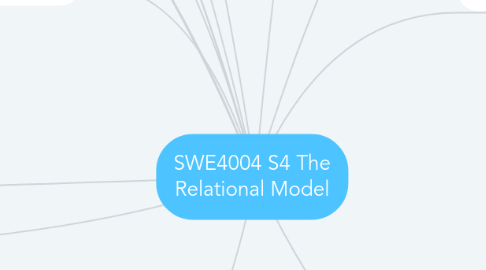
1. In each tuple of R, values of K uniquely identify that tuple (uniqueness).
2. An attribute, or set of attributes, that uniquely identifies a tuple within a relation.
3. Order of attributes has no significance.
4. Each tuple is distinct; there are no duplicate tuples.
5. Values of an attribute are all from the same domain.
5.1. Order of tuples has no significance, theoretically.
6. Relation name is distinct from all other relation names in relational schema.
7. Each attribute has a distinct name.
8. Each cell of relation contains exactly one atomic (single) value.
9. Properties of Relations
10. Relational Keys
10.1. Superkey
10.2. Superkey (K) such that no proper subset is a superkey within the relation.
10.3. Candidate Key
10.3.1. No proper subset of K has the uniqueness property (irreducibility
10.4. Primary Key
10.4.1. Candidate key selected to identify tuples uniquely within relation.
10.5. Alternate Keys
10.5.1. Candidate keys that are not selected to be primary key.
10.6. Foreign Key
10.6.1. Represents value for an attribute that is currently unknown or not applicable for tuple.
10.6.2. Attribute, or set of attributes, within one relation that matches candidate key of some (possibly same) relation.
11. Integrity Constraints
11.1. Null
11.1.1. Deals with incomplete or exceptional data.
11.1.2. Represents the absence of a value and is not the same as zero or spaces, which are values
11.2. Referential Integrity
11.2.1. If foreign key exists in a relation, either foreign key value must match a candidate key value of some tuple in its home relation or foreign key value must be wholly null.
11.3. Entity Integrity
11.3.1. In a base relation, no attribute of a primary key can be null.
11.4. General Constraints
11.4.1. Additional rules specified by users or database administrators that define or constrain some aspect of the enterprise.
12. Purpose and advantages of views.
13. Alternative Terminology for Relational Model
14. Objectives
14.1. Terminology of relational model.
14.2. How tables are used to represent data.
14.3. Connection between mathematical relations and relations in the relational model.
14.4. Properties of database relations.
14.5. Meaning of entity integrity and referential integrity.
14.6. How to identify CK, PK, and FKs.
15. Terminology
15.1. A relation is a table with columns and rows.
15.1.1. Only applies to logical structure of the database, not the physical structure.
